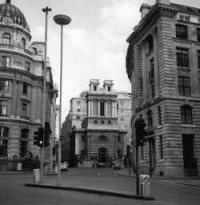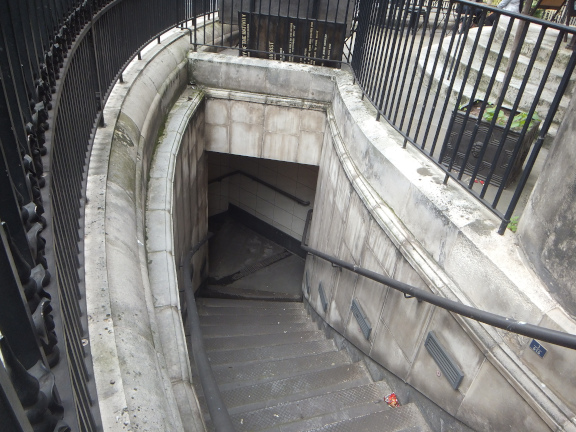

A global archive of independent reviews of everything happening from the beginning of the millennium
Read our Copyright Notice click here
For publication dates click here
 St Mary Woolnoth in the nineties
St Mary Woolnoth in the nineties
Why was I so fascinated by St Mary
Woolnoth?
I had spent great deal of time studying The Waste Land and had much appreciation of it and Eliot's cultural theories that supported it.
Then I was the architect temporarily put in charge of the Underground station below both St Mary Woolnoth and the nine-way road intersection in front of the Bank of England.
Just above ground the biggest controversy in British architecture for a half a century was still raging about whether a Mies van der Rohe tower should be built at one branch of the intersection, a posthumous execution of his design.
On balance I would have preferred it to the interesting but less disruptive James Stirling building that was built.
The Bank of England, the Royal Exchange, the Mansion House, St Mary Woolnoth, St Stephen Walbrook and Lutyens' Midland Bank headquarters all sit on the extended intersection. It is one of the fascinating spaces like Trinity College Great Court that came about by accident. Eliot had been writing about this area, too, where he had worked, in a way that drew together the cultural heritage of Europe, a very important theory in damaged post-war Europe and which helped him win a Nobel prize. He was a wise voice in this space.
Soane, at the Bank of England, had also been an architect not out of keeping with Eliot's cultural theories, seeing things in long perspectives of time and of cultural accumulation and his own place in those perspectives. So he was a bridge to modernism.
In a time when cultural issues were more important than commercial I could see the retail potential of a space underground that linked up all these architectural treasures and which, with a bit of skill, could yield financial rewards to the Underground that selling the crypt had to St Mary Woolnoth.
There are big, probably intractable, issues underground, though. The tunnels have sharp curvatures and the passenger handling capacity of Bank Station fails to readily match the volume of people who seek to use it. There is, it would appear, no space either above ground or below to remedy this adequately. This is a crowded city where you cannot continually add density without starting again, which we are not going to do and destroy our history.
We cannot continually submit to glib demands from those who study a lot less long than architects and vets and doctors to retrofit the cityscape, or domestic buildings, or replace circulation with driverless cars, or kill even more farm animals in the next epidemic, or do without hospital beds and treat everyone in the community, because the length of training is there to see a full picture, and to see the practical difficulties, and to not make too many mistakes, which are spurred on by glib ideologies and decisions.
I stayed on the project for very little time. Pedestrianising this part of the world might just be possible but very difficult. I expect it is more pleasant in the Covid-19 lockdown.
*****
St Mary Woolnoth (written c.1987 and marginally revised in 2000. By then others had twigged that there could be an underground shopping precinct. Now there are too many pile driven foundations for that but under a pristine Mansion House Square it just could have been. I always thought of Les Halles which after the demolition of the historic market provided a toplit underground shopping precinct but that is being demolished now.
It does not matter. The most fascinating piece of streetscape in London remains and the new tower blocks you glimpse from the intersection add to its intrigue. They make the views better, with one or two exceptions, without damaging the history of this place.)
WLNOTMARICHERCHE REVISITED
Reviewed by ANDRE BEAUMONT
20 May 2020
Unreal City,
A crowd flowed over London Bridge, so many,
I had not thought death had undone so many,
Sighs, short and infrequent, were exhaled,
And each man fixed his eyes before his feet,
Flowed up the hill and down King William Street,
To where St Mary Woolnoth kept the hours
With a dead sound on the final stroke of nine,
There I saw one I knew, and stopped him, crying: 'Stetson!
"You who were with me in the ships at Mylae!
This was T.S. Eliot's city cry to the one he recognized from that battle.
Of Ford Madox Ford's Antwerp, he said: "the only good poem I have met with on the subject of war".
I do not recall this being mentioned in the literature but having just read Ford's poem for the first time it is clear that Eliot owes a debt to Ford which is acknowledged by the way The Waste Land is written. Ford may be a minor poet but these are big compliments. Immature poets imitate; mature poets steal.
Written about 1914 and published in 1917, I find Antwerp even more moving in the earlier Belgian sections but that is because I know the city. This is the English section with its similarities, about refugees arriving:
VI
This is Charing Cross;
It is midnight;
There is a great crowd
And no light -
A great crowd, all black, that hardly whispers aloud.
Surely, that is a dead woman - a dead mother!
She has a dead face;
She is dressed all in black;
She wanders to the book-stall and back,
And back again and again back,
She sways and wanders.
This is Charing Cross;
It is one o'clock,
There is still a great crowd, and very little light;
Immense shafts of shadows over the black crowd
That hardly whispers aloud....
And now!... That is another dead mother,
And there is another and another and another....
And little children, all in black,
All with dead faces, waiting in the waiting places,
Wandering from the doors of the waiting room
In the dim gloom.
These are the women of Flanders:
They await the lost.
They await the lost that shall never leave the dock;
They await the lost that shall never again come by train
To the embraces of all these women with dead faces;
They await the lost who lie dead in trench and barrier and fosse,
In the dark of night.
This is Charing Cross; it is past one of the clock;
There is very little light.
There is so much pain.
It is a poem that starts with the line:
GLOOM!
This is a sentiment I personally rarely have but I do worry about British contemporary artistic production. We are currently in the midst of the Covid-19 emergency. If recent years' production is anything to go by the artistic world will swallow the spin and nudging of the media, the output of people known as spin doctors, media and public relations experts, and the American owned and shaped social media, and produce little with any real social commentary worthy of the time. No Guernica or La Peste. No Joan Baez. No Conrad, collaborated with by Ford, so no Heart of Darkness. No long, withdrawing roar. No vital emotions. Some Banksy and a few satirists and that may be it.
Not a reader of war poetry, I like Keith Douglas but Rupert Brooke not so much. Ford Madox Ford, with less literary fame than he would have wanted, cuts through here, even for today. This is a poem worth being remembered for.
'Compressed matter' above the Bank Underground Station
One of the very many exits to the Underground station
No access during Covid-19 to the interior's Ionian white and gold
So Ionian red and gold
Lutyens' Midland Bank and Cooper's National Westminster Bank
Hemmed in by a newer structure on Lombard Street ....
.... but it has the air of biding its time to be more prominent on the extended intersection, which a subterranean development might have delivered for it
A few dozen paces and the intersection really does open out - with the Bank of England, the old stock exchange tower, the old Nat West tower, the Royal Exchange and a new tower in view
The Old Lady with two entrances to the Underground on the corner
Even Underground architects have not found a way into the gold vaults
Well, maybe - it just need the right project
I've been in pretty much all these buildings
There are entrances to the station everywhere

This one an emergency exit tucked within the railings of St Mary Woolnoth
Turn left from Lombard Street and there is George Dance's Mansion House
With views almost to St Paul's and divided by James Stirling's 1 Poultry building
Count the confluence of roads and it comes to nine, one more than Trafalgar Square
Looking past the Royal Exchange
If I could be bothered to carry more than the most pocketable equipment I, too, would be taking bankable shots
The Bank of England in Threadneedle Street
To the left, including the site of 1 Poultry, is where Mansion House Square would have been
A view from what would have been the open space of Mansion House Square
It would have run right up to the flank of the Mansion House
1 Poultry delivers its surprises and is Grade II* listed
Window reveals help the weathering of external window frames and I dislike their disappearance in domestic buildings but Stirling breaks all the rules and makes them deeper and highly coloured in the partly enclosed well of an office building
Reaching for a different architectural vocabulary